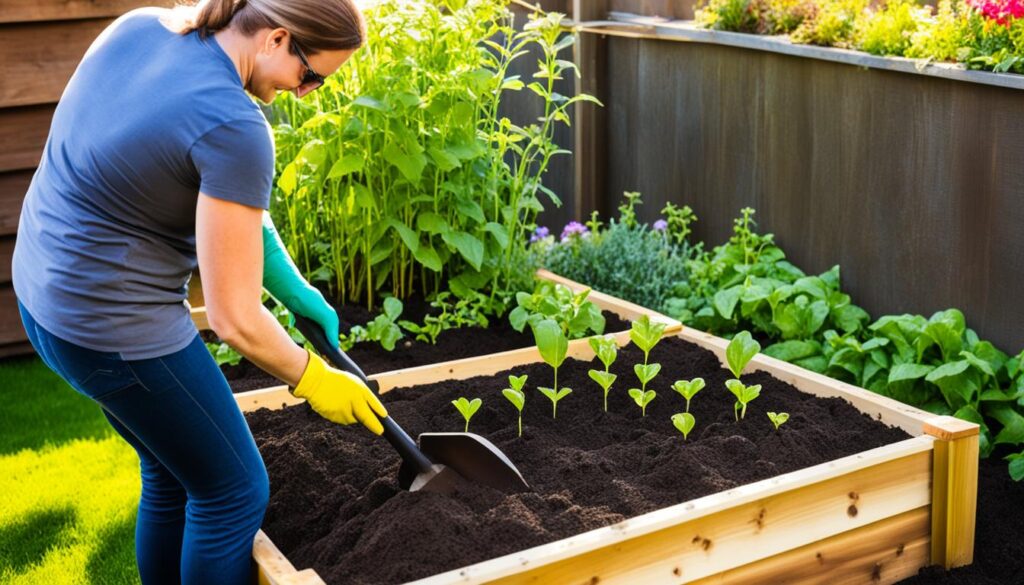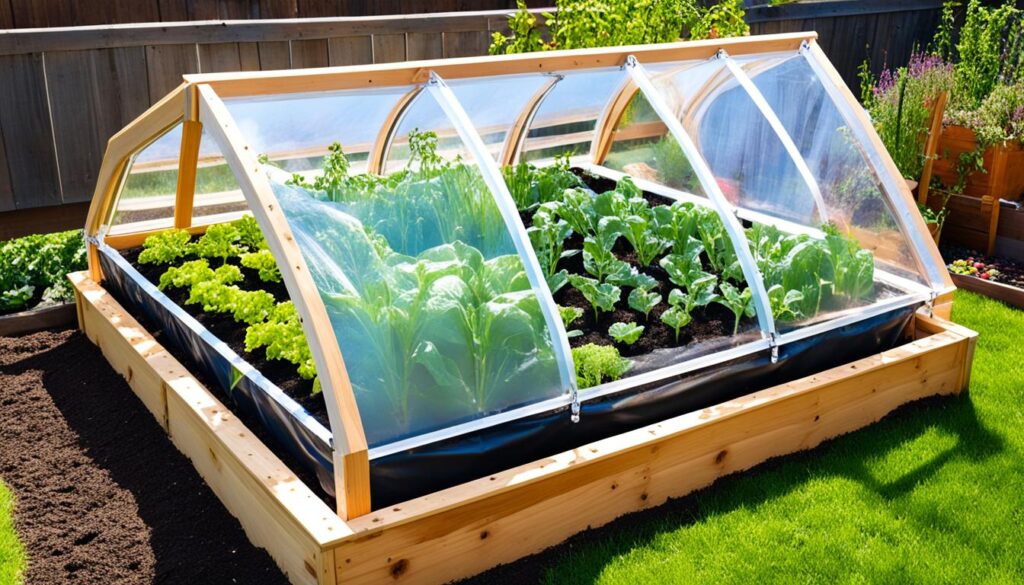Welcome to my comprehensive guide on box hedge care and maintenance. If you’ve noticed your box hedge struggling or even dying, don’t panic! In this article, I will provide expert advice and troubleshooting tips to help you revive your struggling box hedge. From common problems to disease prevention and pruning techniques, I will cover everything you need to know to ensure the health and vitality of your box hedge.
Key Takeaways:
- Proper planting conditions, including partial shade and regular watering, are essential for healthy box hedges.
- Common box hedge problems include diseases like box blight and pests such as box caterpillars.
- Pruning after cold winters and improving air circulation are crucial for reviving struggling box hedges.
- Preventing diseases and pests through good hygiene practices and appropriate treatments is key to maintaining box hedge health.
- Consider alternative plants for box hedges if ongoing issues persist or to avoid potential problems.
Common Box Hedge Problems
Box hedges, with their elegant and structured appearance, are a popular choice in gardens. However, they are not immune to problems that can lead to their decline. Understanding the common box hedge problems, diseases, and pests is key to effectively addressing and preventing them.
Diseases
Box hedges can be susceptible to diseases such as box blight, volutella blight, and rust. These diseases can cause various symptoms, including leaf browning, stem dieback, and overall weakness of the plant. Here are some commonly encountered diseases in box hedges:
| Disease | Symptoms |
|---|---|
| Box Blight | Large, brown patches on leaves and stems |
| Volutella Blight | Dieback of stems, furry pink spore masses on dying leaves |
| Rust | Orange, powdery spots on leaves |
Identifying these diseases early on is crucial for effective treatment and prevention of further spread.
Pests
Box hedges can also fall victim to various pests that can weaken the plant and contribute to its decline. Common pests found in box hedges include box caterpillars and red spider mites. These pests can cause damage to the leaves and inhibit the overall growth and health of the hedge.
Box Caterpillars
Box caterpillars are known to defoliate box hedges, leaving them weak and vulnerable. The caterpillars can be identified by their green color and distinctive black stripes. Infestations can quickly spread and cause significant damage if not addressed promptly.
Red Spider Mites
Red spider mites are tiny arachnids that can infest box hedges and cause leaf discoloration and weakening. They thrive in hot and dry conditions, making them especially problematic during summer months.
Taking prompt action against pests is crucial to prevent further damage and protect the health of your box hedges.
To learn more about preventing and addressing these common box hedge problems, continue reading Section 3: Planting Conditions for Boxwood.
Planting Conditions for Boxwood
Creating the ideal planting conditions is essential for the health and growth of box hedges. Here are some key factors to consider:
Partial Shade and Wind Protection
Boxwood thrives in partial shade, so it’s important to choose a location that provides some shade throughout the day. This helps prevent the plant from being exposed to excessive sunlight and heat, which can cause stress and damage.
Additionally, box hedges should be protected from strong winds. Wind can dry out the foliage and cause dehydration, leading to unhealthy and withered plants. Consider planting your box hedge near a building, fence, or other natural barriers to shield it from strong gusts.
Proper Watering
Consistent and adequate watering is crucial for the health of box hedges. The soil around the hedge should be kept moist, especially during hot and dry periods.
Water the hedge deeply and evenly, ensuring that the soil is thoroughly saturated. Avoid overwatering, as this can lead to waterlogged roots and root rot. Instead, aim to provide a steady supply of moisture to the roots, allowing them to access nutrients and thrive.
Mulching for Retaining Moisture
Mulching is an effective technique for retaining moisture and providing nutrients to box hedges. Apply a layer of organic mulch, such as wood chips or compost, around the base of the hedge.
The mulch helps to conserve moisture in the soil, reducing the need for frequent watering and preventing the soil from drying out too quickly. It also acts as a natural fertilizer, enriching the soil and promoting healthy growth.
Soil Preparation
Before planting a box hedge, it’s important to prepare the soil properly to create optimal conditions for growth. Here are some steps to follow:
- Clear the planting area of any weeds, rocks, or debris.
- Loosen the soil with a garden fork or tiller to improve drainage and root penetration.
- Amend the soil with organic matter, such as compost or well-rotted manure, to enrich its fertility.
- Ensure that the soil has a slightly acidic to neutral pH level, ideally between 6.0 and 7.0.
By following these planting conditions, you can provide the best possible environment for your box hedges to thrive and flourish. Remember to monitor the moisture levels, regularly mulch, and maintain proper soil fertility to ensure the long-term health and beauty of your box hedges.
Pruning After Cold Winters
Cold winters can take a toll on box hedges, causing them to turn brown and become damaged. To ensure the health and vitality of your box hedge, it is essential to perform proper pruning after winter. Pruning not only helps remove cracked and brown branches but also stimulates fresh growth in the spring, rejuvenating the hedge.
When pruning box hedges after winter, it’s important to assess the extent of the damage. If there are only a few damaged branches, you can simply cut them back to healthy growth using sharp pruning shears. However, if the entire plant has suffered extensive damage, it may be necessary to perform a more drastic pruning by cutting back the hedge to the stem.
By starting afresh with a severe pruning, you create space for new growth and allow the box hedge to revive itself. However, remember that such severe pruning should only be done in early spring to ensure the best chance of recovery.
It’s important to note that while pruning is necessary to rejuvenate a box hedge after a harsh winter, it’s crucial to avoid pruning during freezing temperatures. Pruning during freezing conditions can further damage the hedge and hinder its ability to recover.
Tips for Pruning After Cold Winters:
- Assess the level of damage: Determine if only specific branches need to be pruned or if a more extensive pruning is required.
- Use sharp pruning shears: Make clean cuts to promote proper healing and reduce the risk of infection.
- Start early: Perform the necessary pruning in early spring when the risk of frost has passed.
- Remove all damaged and dead branches: Cut back to healthy growth to encourage new shoots.
- Maintain a balanced shape: Trim the hedge to maintain its shape and promote even growth.
Remember, pruning after cold winters is a crucial step in reviving a box hedge. By cutting back damaged branches and stimulating new growth, you can help your box hedge recover from the winter’s harsh effects and ensure its continued health and beauty.
Airing the Branches
To improve the health of your box hedge, it is crucial to consider air circulation within the plant. Dense foliage can create a humid environment that promotes the growth of fungi and diseases. By pruning the interior branches in early spring, you can open up the hedge, allowing fresh air to reach the inner parts of the plant.
Airing the branches is a simple yet effective technique for preventing fungal diseases and revitalizing struggling box hedges. By trimming away excess growth, you can create space between the branches, allowing for better air flow and reducing moisture buildup. This helps in preventing conditions that are conducive to the growth of harmful fungi.
“Improving air circulation in box hedges is vital for maintaining their health and preventing fungal diseases. Pruning the interior branches allows for better ventilation and reduces the risk of humidity-related issues.”
When pruning the branches, focus on removing overcrowded and overlapping growth. By selectively thinning out the interior branches, you create an open structure that allows air to circulate freely. This not only helps in preventing diseases but also promotes overall plant vigor and growth.
Box Hedge Disease Prevention
Box hedges are known for their elegance and beauty, but they are also susceptible to various diseases that can threaten their health and vitality. To maintain healthy box hedges, it is important to take preventive measures to avoid the onset and spread of diseases. By following proper hygiene practices, implementing suitable treatments, and ensuring good care, you can effectively control and prevent box hedge diseases.
Preventing Box Hedge Diseases
- Clean pruning tools regularly: It is essential to clean your pruning tools after each use to prevent the transmission of diseases. Use a disinfectant solution or rubbing alcohol to sterilize the tools and prevent the spread of pathogens.
- Remove fallen leaves: Fallen leaves can harbor fungal spores and pests that can infect box hedges. Regularly remove and dispose of fallen leaves to eliminate potential sources of diseases.
- Avoid over-watering: Excessive moisture can create a humid environment that encourages the growth of fungal diseases. Water your box hedges appropriately, ensuring the soil is moist but not saturated.
Treating Box Hedge Diseases
If your box hedges do develop diseases, it is important to take prompt action to address the issue and prevent further damage. Research the specific disease affecting your hedges and follow appropriate treatment methods. This may involve using fungicides, pruning infected parts, or applying organic remedies. Consulting with a professional gardener or horticulturist can provide valuable guidance in treating box hedge diseases effectively.
Maintaining Healthy Box Hedges
In addition to disease prevention and treatment, maintaining overall hedge health is crucial for the longevity and resilience of box hedges. Regularly inspect your hedges for any signs of diseases or pests, analyze environmental conditions such as lighting and soil moisture, and provide appropriate care and maintenance.
Following these preventive measures and ensuring the overall health of your box hedges will help them thrive and remain beautiful additions to your garden.
| Box Hedge Disease | Prevention Tips |
|---|---|
| Box Blight | Prune infected areas promptly and dispose of diseased material properly. Avoid overhead watering and maintain good air circulation. |
| Rust | Remove infected leaves and ensure proper air circulation. Avoid planting box hedges in areas prone to high humidity. |
| Leaf Spot | Avoid overhead watering and keep the foliage dry. Dispose of infected leaves and provide adequate spacing between plants. |
| Root Rot | Ensure proper drainage by planting box hedges in well-draining soil. Avoid over-watering and waterlogged conditions. |
Box Caterpillars and Other Pests
Box hedges can be susceptible to various pests, including box caterpillars and red spider mites. These pests can cause significant stress and contribute to the decline of box hedges. To ensure the health and vitality of your box hedge, it is essential to be proactive in identifying and controlling these pests.
Box Caterpillar Infestation
One common pest that affects box hedges is the box caterpillar. These voracious caterpillars can quickly strip the leaves from your hedge, leaving it weak and vulnerable. To control a box caterpillar infestation:
- Regularly inspect your box hedge, paying close attention to the undersides of leaves where the caterpillars may hide.
- If you spot any caterpillars, carefully remove them by hand, disposing of them safely.
- Consider introducing natural predators, such as birds or parasitic wasps, to help control the caterpillar population.
Red Spider Mites in Box Hedges
Red spider mites are another common pest that can infest box hedges. These tiny arachnids thrive in dry and warm conditions, often resulting in discoloration and webbing on the leaves. To combat red spider mites:
- Regularly spray your box hedge with water to increase humidity, reducing the favorable conditions for mite infestation.
- Consider introducing predatory mites or beneficial insects, such as ladybugs, to naturally control the mite population.
- If infestation persists, you may need to resort to insecticidal soap or horticultural oil to eliminate the mites. Follow the instructions carefully and avoid using chemical sprays during peak flowering periods to protect beneficial insects.
By staying vigilant and taking appropriate measures, you can effectively control box caterpillars and red spider mites, protecting the health of your box hedge. Regular inspection and prompt action are key to preventing severe infestations that may require more drastic interventions.

Comparison of Box Caterpillars and Red Spider Mites
| Pest | Damage Caused | Control Methods |
|---|---|---|
| Box Caterpillars | Severe leaf stripping, weakens the hedge |
|
| Red Spider Mites | Leaf discoloration, webbing |
|
Box Blight
One of the most challenging issues that box hedges can face is box blight. This fungal disease can quickly spread and cause significant damage to box plants if not addressed promptly. Recognizing the symptoms of box blight, treating the disease effectively, and taking preventive measures are crucial for maintaining the health and beauty of your box hedges.
Symptoms of Box Blight
Identifying the symptoms of box blight early on is essential for effective treatment. Look out for the following signs:
- Leaf browning and discoloration
- Dark brown or black lesions on stems and branches
- Foliage thinning and loss
- Stem dieback and overall decline
If you notice these symptoms in your box hedges, it is crucial to take immediate action to prevent further spread and damage.
Treating Box Blight
To treat box blight, it is important to act quickly and decisively. Here are some steps you can take:
- Prune affected areas: Cut out and remove any infected branches, stems, or foliage. Make sure to clean your pruning tools between cuts to avoid spreading the disease.
- Apply fungicides: Use fungicidal sprays or treatments recommended for box blight. Follow the instructions carefully and apply according to the recommended dosage.
- Improve air circulation: Trim the interior branches of the hedge to promote better air circulation. This can help prevent the disease from spreading and create a less favorable environment for fungal growth.
Preventing Box Blight Spread
Preventing the spread of box blight is crucial to protect the health of your box hedges. Here are some preventive measures you can take:
- Maintain good hygiene: Clean your pruning tools thoroughly after each use, and dispose of any infected plant material properly. This will help prevent the disease from spreading to healthy plants.
- Avoid wet conditions: Box blight thrives in humid environments, so avoid over-watering your box hedges. Water them at the base rather than overhead to minimize the moisture on the leaves.
- Monitor regularly: Keep a close eye on your box hedges for any signs of disease or pest infestation. Early detection can help prevent the spread of box blight and allow for timely treatment.
By being proactive and implementing these preventive measures, you can reduce the risk of box blight and ensure the long-term health of your box hedges.
Alternative Plants for Box Hedges
If your box hedges are struggling or if you are looking to avoid potential problems, there are alternative plants that can be used as substitutes. These alternatives offer a similar effect to box hedges while being resistant to diseases. Here are some examples:
- Wilson’s honeysuckle: A beautiful climbing plant with fragrant flowers.
- Japanese holly: A versatile evergreen shrub that can be shaped into hedge forms.
- Euonymus varieties: There are various euonymus species, such as Euonymus japonicus and Euonymus fortunei, that can be used as hedging plants.
- Yew: A classic choice for hedges, yew is disease-resistant and can be pruned into various shapes.
- Flowering plants: Consider using flowering shrubs like lavender, rosemary, or hydrangeas to add color and interest to your landscape.
These alternative plants can provide a refreshing change while still achieving the desired effect. They offer disease resistance, ensuring the longevity and health of your hedge.
If you need further assistance in choosing the right alternative plants for your needs, consult with a local gardening expert or visit your nearest nursery. They can provide personalized recommendations based on your specific requirements and local climate.
Remember, exploring alternative plants can be an exciting way to diversify your garden and create a unique landscape.

Comparison of Alternative Plants for Box Hedges
| Plant | Disease Resistance | Growth Habit | Special Features |
|---|---|---|---|
| Wilson’s honeysuckle | High | Climbing | Fragrant flowers |
| Japanese holly | High | Evergreen shrub | Can be shaped into hedges |
| Euonymus varieties | Medium | Evergreen shrub | Various species available |
| Yew | High | Evergreen shrub | Can be pruned into various shapes |
| Flowering plants | Varies by species | Varies by species | Colorful blooms |
Tips for Reviving Box Hedges
Reviving struggling box hedges requires addressing the underlying issues that have caused their decline. By taking targeted actions and following expert advice, you can restore the health and vigor of your box hedges.
To begin, evaluate the planting conditions of your box hedges. Ensure they are placed in a suitable location, offering partial shade and protection from strong winds. Adequate watering is crucial, especially during hot and dry periods, to prevent the plants from becoming stressed.
Inspect your box hedges for any damaged branches and promptly prune them to stimulate new growth. Be sure to use proper pruning techniques and tools to avoid further damage. Additionally, improving air circulation within the hedge by selectively trimming interior branches can prevent the buildup of humidity and reduce the risk of fungal diseases.
If your box hedges are suffering from diseases or pest infestations, it is important to take appropriate measures for treatment. Research the specific issues affecting your hedges and consult with experts for recommended solutions. Treatments may include the application of appropriate fungicides or the use of biological controls for pest management.
While addressing specific issues, it is crucial to implement proper care and maintenance practices to maintain the health of your box hedges in the long term. This includes regular monitoring, timely pruning, providing sufficient water and mulching, and practicing good hygiene by removing fallen leaves and debris.
Remember, every box hedge is unique, and the revival process may vary depending on the individual circumstances. By following these expert tips and taking the necessary actions, you can restore your struggling box hedges to their former glory.
Expert Tip:
“Regular monitoring and proactive care are essential for reviving struggling box hedges. By promptly addressing any issues and providing the necessary attention, you can restore the health and vitality of your hedges.” – [Expert Name], [Title]
Maintaining Healthy Box Hedges
Keeping your box hedges in optimal condition involves regular care and maintenance. By following expert tips and implementing preventive measures, you can ensure the health and vitality of your box hedges. Here are some essential practices to help you maintain healthy box hedges:
1. Regular Pruning
Pruning is an important aspect of box hedge maintenance. Regularly trim the hedge to maintain its desired shape and size. Pruning also helps remove dead or diseased branches, promoting new growth and overall health.
2. Monitoring for Diseases and Pests
Keep a close eye on your box hedges for any signs of diseases or pests. Box hedges are susceptible to various issues, such as box blight and caterpillar infestations. Regular inspection allows for early detection and treatment, preventing further damage.
3. Proper Watering and Mulching
Provide your box hedges with adequate water to keep the soil moist. Watering deeply and less frequently is preferable to shallow and frequent watering. Applying mulch around the base of the hedge helps retain moisture, prevent weed growth, and provide essential nutrients.
4. Ensuring Good Air Circulation
Promote good air circulation within your box hedges by pruning the interior branches. This helps prevent the development of fungal diseases and maintains overall health. Trimming the branches allows air to penetrate the hedge, keeping it fresh and vibrant.
5. Implementing Preventive Measures
Take preventive measures to protect your box hedges from diseases and pests. Maintain good hygiene by removing fallen leaves and debris around the hedge, as they can harbor pathogens. Use appropriate treatments, such as fungicides and natural predators, to deter and control pests.
Following these expert tips will help you keep your box hedges thriving and beautiful for years to come.

Conclusion
In conclusion, reviving struggling box hedges requires a comprehensive approach focused on addressing various factors affecting their health. By carefully tending to the planting conditions, ensuring proper pruning of damaged branches, taking preventative measures against diseases and pests, and maintaining overall hedge health, it is possible to bring them back to their vibrant and beautiful state.
Expert advice plays a crucial role in successfully reviving box hedges. Professionals recommend creating an optimal environment by providing partial shade, protecting the hedges from harsh winds, and maintaining consistent moisture through regular watering and mulching. In addition, frequent inspections for diseases and pests, prompt treatment, and good hygiene practices are essential to prevent further decline.
Remember, the key to achieving longevity and vitality for your box hedges lies in following expert advice and taking appropriate actions. With a combination of care, attention, and patience, you can successfully revive and maintain the health of your box hedges, adding timeless beauty and structure to your garden.








